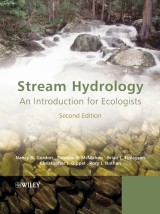Details

Stream Hydrology
An Introduction for Ecologists2. Aufl.
|
71,99 € |
|
| Verlag: | Wiley |
| Format: | EPUB |
| Veröffentl.: | 03.05.2013 |
| ISBN/EAN: | 9781118688175 |
| Sprache: | englisch |
| Anzahl Seiten: | 448 |
DRM-geschütztes eBook, Sie benötigen z.B. Adobe Digital Editions und eine Adobe ID zum Lesen.
Beschreibungen
Since the publication of the first edition (1994) there have been rapid developments in the application of hydrology, geomorphology and ecology to stream management. In particular, growth has occurred in the areas of stream rehabilitation and the evaluation of environmental flow needs. The concept of stream health has been adopted as a way of assessing stream resources and setting management goals.<br> <br> Stream Hydrology: An Introduction for Ecologists Second Edition documents recent research and practice in these areas. Chapters provide information on sampling, field techniques, stream analysis, the hydrodynamics of moving water, channel form, sediment transport and commonly used statistical methods such as flow duration and flood frequency analysis. Methods are presented from engineering hydrology, fluvial geomorphology and hydraulics with examples of their biological implications. This book demonstrates how these fields are linked and utilised in modern, scientific river management.<br> * Emphasis on applications, from collecting and analysing field measurements to using data and tools in stream management.<br> * Updated to include new sections on environmental flows, rehabilitation, measuring stream health and stream classification.<br> * Critical reviews of the successes and failures of implementation.<br> * Revised and updated windows-based AQUAPAK software.<br> <br> This book is essential reading for 2nd/3rd year undergraduates and postgraduates of hydrology, stream ecology and fisheries science in Departments of Physical Geography, Biology, Environmental Science, Landscape Ecology, Environmental Engineering and Limnology. It would be valuable reading for professionals working in stream ecology, fisheries science and habitat management, environmental consultants and engineers.
Preface for the Second Edition. <p>Preface for the First Edition.</p> <p>1. Introducing the Medium.</p> <p>1.1 Water as a Fluid.</p> <p>1.2 The Physics of Fluids.</p> <p>1.3 Physical Properties of Water.</p> <p>2. How to Study a Stream.</p> <p>2.1 Focusing on Physical Habitat.</p> <p>2.2 The Planning Process.</p> <p>2.3 Strategic Sampling.</p> <p>2.4 Know Your Limitations.</p> <p>2.5 Examples of How and How not to Conduct a Study (by M. Keough).</p> <p>3. Potential Sources of Data (How to Avoid Reinventing the Weir).</p> <p>3.1 Data types.</p> <p>3.2 Physical Data Sources, Format, and Quality.</p> <p>3.3 Maps: Finding those Spatial Places.</p> <p>3.4 Photographs and other remotely sensed data.</p> <p>4. Getting to Know Your Stream.</p> <p>4.1 Gene ral character.</p> <p>4.2 Catchment Characteristics.</p> <p>4.3 Streamflow Hydrographs.</p> <p>4.4 How Does This Stream Measure Up?</p> <p>5. How to Have a Field Day and Still Collect Some Useful Information.</p> <p>5.1 Venturing into the Field.</p> <p>5.2 Surveying: A Brief Introduction.</p> <p>5.3 Methods of Measuring Areal Extent.</p> <p>5.4 Surveying Streams.</p> <p>5.5 Measurement of Water Level or Stage.</p> <p>5.6 Measurement of Discharge (Streamflow).</p> <p>5.7 Substrates and Sediments: Sampling and Monitoring Methods.</p> <p>5.8 Substrates and Sediments: Analysis of Physical Properties.</p> <p>5.9 Water Quality.</p> <p>6. Water at Rest and in Motion.</p> <p>6.1 General.</p> <p>6.2 Hydrostatics: The Restful Nature of Water.</p> <p>6.3 Studying the Flow of Fluids.</p> <p>6.4 Narrowing the Focus: Flow of a Viscous Fluid.</p> <p>6.5 The Microenvironment: Flow Near Solid Surfaces.</p> <p>6.6 Open-channel Hydraulics: The Macro-environment.</p> <p>7. It’s Sedimentary, Watson!</p> <p>7.1 Introduction to Stream Channels, Streambeds and Transported Materials.</p> <p>7.2 Stream-shaping Processes.</p> <p>7.3 The Ins and Outs of Channel Topography.</p> <p>7.4 Sediment Motion.</p> <p>7.5 Sediment Yield from a Catchment.</p> <p>8. Dissecting Data with a Statistical Scope.</p> <p>8.1 Introduction.</p> <p>8.2 Streamflow Frequency Analysis.</p> <p>8.3 Flow-duration Curves.</p> <p>8.4 Flow-Spell Analysis.</p> <p>8.5 Extrapolating from the Known to the Unknown.</p> <p>8.6 Numerical Taxonomy: Multivariate Analysis Techniques.</p> <p>9. "Putting It All Together": Assessing Stream Health, stream Classification, Environmental Flows and Rehabilitation.</p> <p>9.1 Putting Theories into Practice.</p> <p>9.2 understanding Stream Values.</p> <p>9.3 Assessing Streamn Health.</p> <p>9.4 The Use of Steam Classification in Management.</p> <p>9.5 Assessing Instream Environmental Flows.</p> <p>9.6 Steam Rehabilitation.</p> <p>Appendix: Basic Statistics.</p> <p>References.</p> <p>Index.</p> <p>Appendix 1 Basic Statistics.</p> <p>References.</p>
<p><b>Nancy D. Gordon</b> is the author of <i>Stream Hydrology: An Introduction for Ecologists</i>, 2nd Edition, published by Wiley.</p> <p><b>Thomas A. McMahon</b> is the author of <i>Stream Hydrology: An Introduction for Ecologists</i>, 2nd Edition, published by Wiley.</p> <p><b>Brian L. Finlayson</b> is the author of <i>Stream Hydrology: An Introduction for Ecologists</i>, 2nd Edition, published by Wiley.</p> <p><b>Christopher J. Gippel</b> is the author of <i>Stream Hydrology: An Introduction for Ecologists</i>, 2nd Edition, published by Wiley.</p> <p><b>Rory J. Nathan</b> is the author of <i>Stream Hydrology: An Introduction for Ecologists</i>, 2nd Edition, published by Wiley.</p>
Water plays an important part in today's environmental concerns. Since the publication of the first edition there have been rapid developments in the application of hydrology, geomorphology and ecology to stream management. In particular, growth has occurred in the areas of stream rehabilitation and the evaluation of environmental flow needs. The concept of stream health has been adopted as a way of assessing stream resources and setting management goals. <p><i>Stream Hydrology: An Introduction for Ecologists Second Edition</i> documents recent research and practice in these areas. Chapters provide information on sampling, field techniques, stream analysis, the hydrodynamics of moving water, channel form, sediment transport and commonly used statistical methods such as flow duration and flood frequency analysis. Methods are presented from engineering hydrology, fluvial geomorphology and hydraulics with examples of their biological implications. This book demonstrates how these fields are linked and utilised in modern, scientific river management.</p> <ul> <li><i>Emphasis on applications, from collecting and analysing field measurements to using data and tools in stream management.</i></li> <li><i>Updated to include new sections on environmental flows, rehabilitation, measuring stream health and stream classification.</i></li> <li><i>Critical reviews of the successes and failures of implementation.</i></li> <li><i>Revised and updated windows-based software.</i></li> </ul> This book is essential reading for 2<sup>nd</sup>/3<sup>rd</sup> year undergraduates and postgraduates of hydrology, stream ecology and fisheries science in Departments of Physical Geography, Biology, Environmental Science, Landscape Ecology, Environmental Engineering and Limnology. It would be valuable reading for professionals working in stream ecology, fisheries science and habitat management, environmental consultants and engineers.

















